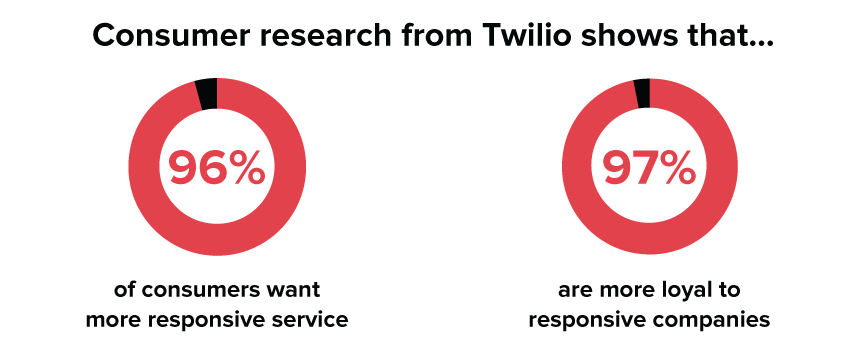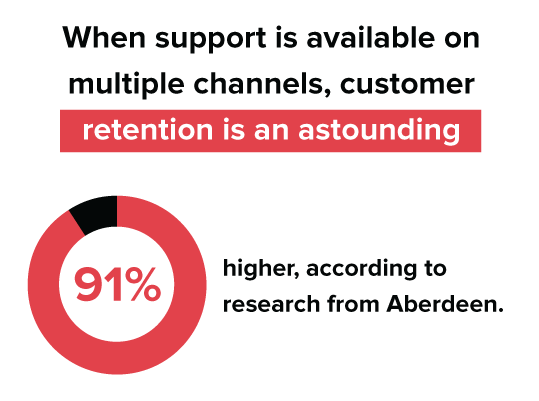Bridge the generation gap when it comes to customer communication by serving all generations, on all channels, with one contact centre platform
Marketers have long known that each generation communicates differently from the previous one. It’s wisdom that has been passed down from marketer to marketer for, well, generations. But it’s not enough to just consider how to tailor your message to audiences of different ages, you also need to think about the different ways you’ll communicate that message.
Communications technologies and new channels appear all the time, forcing marketers to rethink their customer communications strategy every few years. While many current communications strategies were designed with older consumers in mind, a refresh is in order.

As of 2019, Millennials and Generation Z make up the largest percentage of the general population, according to research firm Mintel. Generation Z alone is already responsible for $44 billion in spending and directly influences another $600 billion. Marketers who can’t speak to consumers under the age of 40 might risk alienating the economy’s most important buying groups.
If you can master the channels preferred by each generation, you’ll have already won half the battle. Consumers of any age are more receptive to messages if they’re delivered in ways that feel comfortable for them. But you can’t judge a book by its cover.
Dig into the data
One of the worst mistakes that marketers make in their messaging to different generations is relying on stereotypes to do the work that should be informed by data. Consumers constantly surprise marketers with how they prefer to interact and communicate with brands.
For example, you would be right in thinking that advances in technology are expanding the divide between generations, but you’d be wrong in thinking that older consumers are automatically tech-averse. In fact, one study found that Millennials and Baby Boomers favour chatbots for the same reasons and with the same amount of enthusiasm. Technology has changed how every generation, not just the digital natives, interacts with brands.
Companies are eager to update their technology to meet these demands, but legacy systems are a drag on progress – meaning that some brands ineffectively focus their customer engagement technology on just one customer segment.
Many cloud-based contact centres, for example, rely on a patchwork of short-term solutions and half-fixes rather than invest in new systems that have options for all types of customers. A smarter approach to generational customization is an important start. Knowing what customers want makes it possible to deliver exactly that.
How each generation wants to communicate
Is your marketing department taking a close enough look at how you’re communicating with different customers? As you review your customer communications strategy, explore the preferences of each generation individually.
Baby boomers
Older consumers are used to interacting with companies over the phone and that preference still holds for many in the Baby Boomer generation (born between 1946 and 1964). Having to dial customer service doesn’t feel like a burden to these consumers and some will actually be upset if a telephone option is not available. Serving these customers means preserving a teleservice infrastructure. Unfortunately, that can be expensive.
In this case, don’t look for technology that replaces that infrastructure; look for technology that improves it. For instance, an automated interactive voice response system can interpret what callers need and guide them through call trees more efficiently, which is a win for all involved. Boomers get the comfort of the phone call along with a speedier path to service while companies use automation to cut costs and enhance the customer experience.
Generation X
Born between 1965 and 1980, this was the first generation to embrace the internet, giving it a different perspective on digital communication. One survey found that 92% of Generation X respondents had used email in the previous month compared to just 85% of Generation Z respondents. Another survey found that 67% of Generation X shoppers enjoy receiving personalized emails based on their interests and shopping history.
In a rush to build a cutting-edge communications strategy, it’s easy to overlook old, reliable email. But as Generation X demonstrates, email outreach is still actively preferred by some consumers. If they can’t get a quick reply from customer service through email, they’ll see that company as unhelpful. Even if the customer service is otherwise exceptional, the lack of email defines the entire experience for this customer.

Millennials
Consumers who are used to receiving information on demand have little patience for call centre queues and over-the-phone chit-chat. Millennials, the generation born between 1981 and 1996, want to get support as efficiently and directly as possible, which is why text messaging is so popular with this group. These consumers are twice as likely to want outreach in text-based form, whether through social media or bulk SMS.
Meeting the preferences of Millennials will help you connect with a powerful buying group, and text-based support has a lot of advantages for marketers, too. It can be largely automated, which leads to lower costs, and it resolves support requests quicker than other channels. Consumer research from Twilio shows that 96% of consumers want more responsive service and 97% are more loyal to responsive companies. Texting offers a responsive solution.
Generation Z
You might have noticed a kind of logic to the previous generational preferences. Each generation gravitates to the dominant technology of the time. With Generation Z, born 1997 and on, that pattern goes out the window. This is a generation that is used to information flowing freely, securely and with lots of options for personalization.
Generation Z sees little distinction between business and social communications. These consumers view almost any type of engagement as being loaded with commercial potential, but the massive variety of customer engagement options available makes it hard to deliver a focused message to them.

The key is to make that message as accessible as possible. These younger consumers might want to call customer support one day, have a video chat the next and then jump over to Facebook to continue the conversation. The good news is that if you’re already optimizing your messaging for different generations, you have a solid foundation for this level of omnichannel engagement. When support is available on multiple channels, customer retention is an astounding 91% higher, according to research from Aberdeen.
The multigenerational contact centre
An important question remains unanswered: is it better to add new communications channels or improve those that already exist? Well, modern technology is making that question irrelevant by streamlining the old and integrating it with the new. Companies don’t need to devise a radically different communications strategy out of thin air. They simply must embrace a modern approach and adopt tools that are already available.
With the advent of the programmable contact centre platform, you can reach your customers on any channel they prefer.
Here’s the takeaway: when you rethink your customer communications strategy, bridge the generation gap by serving all generations, on all channels, with one contact centre platform. To avoid a long ramp time, choose a platform that’s instantly deployable. Remember that a fully customizable system creates the exact experience your customers want.
